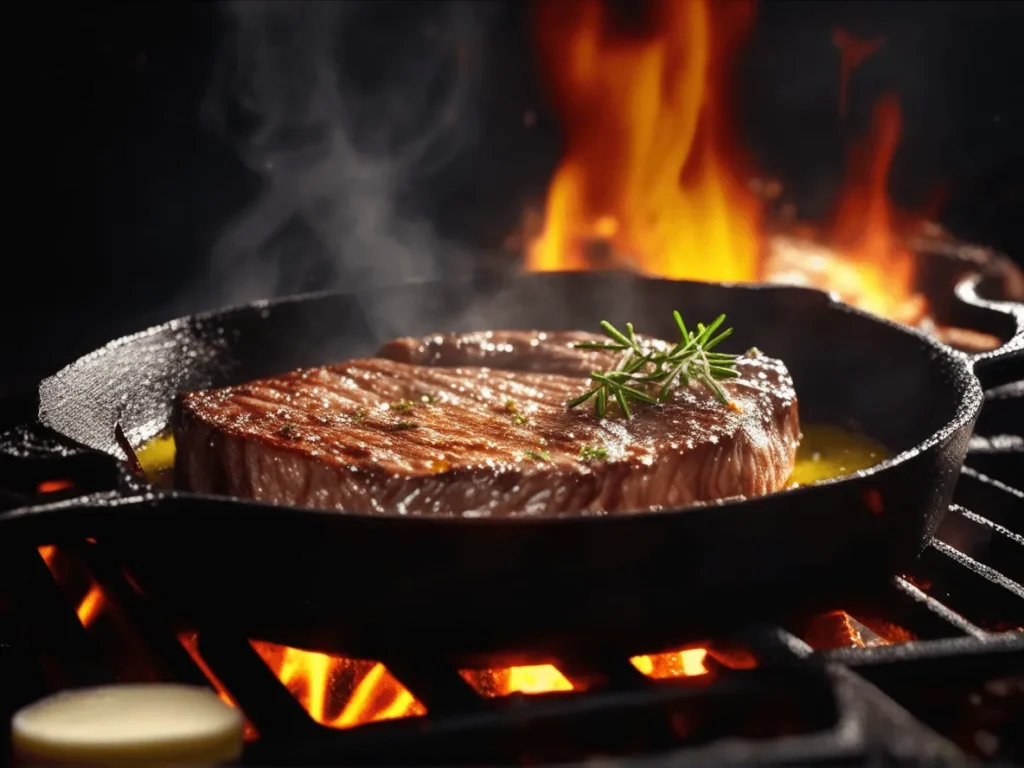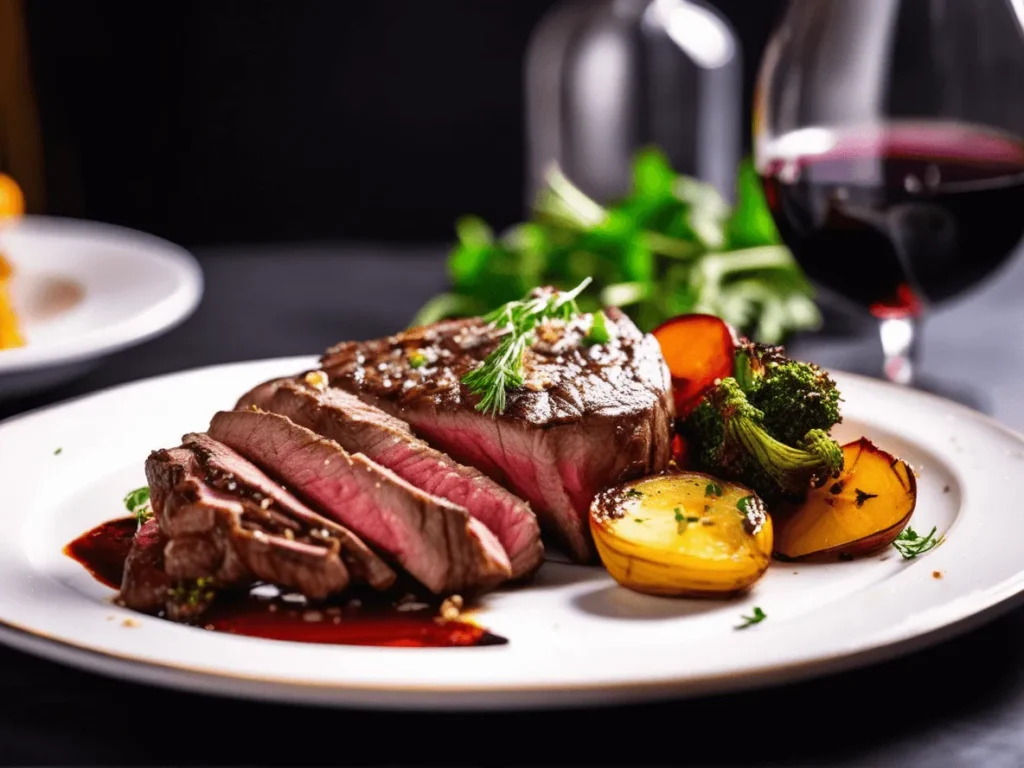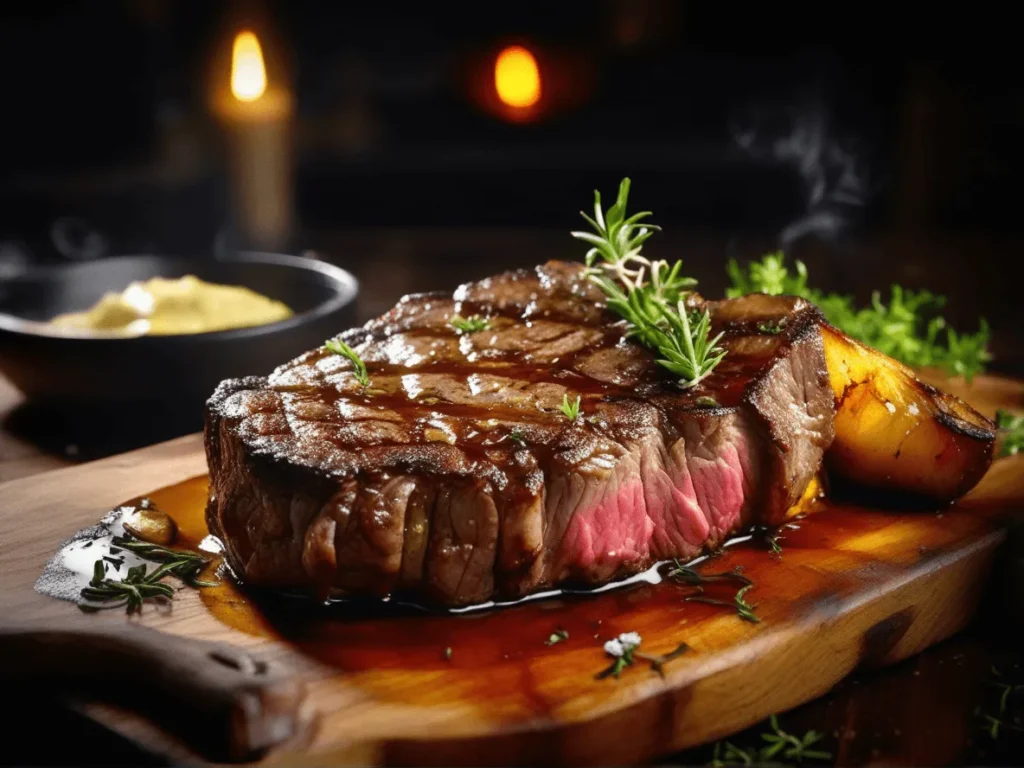How to Make the Perfect Steak with Garlic Butter
Ever felt that panic before flipping a steak? You know the one—when you’re sweating over the stove, wondering if your garlic butter steak will turn out juicy and golden… or dry and sad. You’re not alone. We’ve all been there: candles lit, guests waiting, and a skillet hissing like it’s judging your life choices.
Here’s the deal: steak with garlic butter isn’t magic. It’s science, patience, and knowing why the steps matter. This isn’t just dinner—it’s proof that simple ingredients, treated right, can make your kitchen feel like a fancy steakhouse.
Midway through this guide, we’ll break down the perfect steak with garlic butter —from searing to resting—and by the end, you’ll have a rock-solid steak with garlic butter recipe to call your own.

Table of Contents
The Best Garlic Butter for Steak? This One Wins Every Time
Pan-Seared Steak with Garlic Butter is the ultimate dinner hack. You’re not just cooking—you’re flexing. One bite, and everyone’s like, “Wait, did you learn this from a chef?” Nope. Just a hot pan, a hunk of meat, and butter that’s been smashed with garlic like you’re angry at it (you’re not, but hey).
Why does this combo rule? Because simple beats fancy. Google says searches for “easy steak recipes” jump 30% every weekend. People want meals that feel special but don’t take all day. With this dish, you get that crackle of a perfect crust, the richness of butter, and zero stress. Dry steak? Never heard of her.
10 Tips to Nail How to Cook Steak with Garlic Butter (No Fuss, No Fail)
You’re not just throwing meat on a pan—you’re making The Perfect Steak with Garlic Butter . Let’s skip the fluff and get to the point. Here’s how to crush it, step by step:
1 Pick the Right Cut
Ribeye = juicy and rich. Sirloin = budget-friendly. Filet mignon = fancy. Thickness matters—1.5 inches thick means crispy outside, pink inside.
2 Let It Warm Up
Cold meat = disaster. Leave it out for 30–60 minutes. Pat dry right before seasoning. Moisture = steaming, not searing.
3 Salt Early, Pepper Late
Salt 40 minutes ahead = tender meat. Pepper? Add it right before cooking. Burnt pepper = bitter mess.
4 Heat the Pan Like a Pro
Cast iron is king. Heat until smoking. Test it: flick water in. If it dances and evaporates, you’re good. Nonstick pans? Not for this.
5 Sear Like You Mean It
Don’t crowd the pan. Flip once. After flipping, add butter, smashed garlic, herbs. Spoon melted butter over the steak for 2–3 minutes.
6 Don’t Guess the Temp
Use a meat thermometer. Pull at 130°F for medium-rare. Carryover cooking does the rest.
7 Rest the Meat
Let it sit 5–10 minutes. Tent with foil loosely—don’t smother. Cutting too soon = dry steak.
8 Slice the Right Way
Look at the meat’s lines. Cut across them. Sharp knife only—no sawing. Tender bites = happy eaters.
9 Finish with Flair
Flaky salt (like Maldon) adds crunch. Squeeze lemon or drizzle truffle oil. Don’t go ham with salt—it’s strong.
10 Make a Quick Pan Sauce
After cooking, pour off extra fat but leave browned bits. Add wine or broth, scrape the pan, swirl in butter. Boom—sauce in 5 minutes.
Final Note: This isn’t rocket science. With these 10 tips, your steak with garlic butter recipe will look like it came from a $50 steakhouse. Your guests will think you trained in Paris. You’ll just know you didn’t mess it up.
Flavor Variations :
Creamy : Finish with a splash of heavy cream.
Herb-Infused : Add rosemary, thyme, or sage.
Spicy : Stir in chili flakes or a dash of hot sauce.
Garlic Butter Steak Recipe
| Ingredients | Quantity |
|---|---|
| Ribeye steak (1.5 inches thick) | 2 steaks |
| Unsalted butter | 4 tbsp |
| Fresh garlic cloves | 4, smashed |
| Fresh thyme | 2 sprigs |
| Kosher salt | To taste |
| Black pepper | To taste |
Instructions :
- Pat steaks dry with paper towels. Season with salt 40 minutes before cooking.
- Heat a cast-iron skillet until smoking. Add 1 tbsp oil. Sear steaks 2–3 minutes per side.
- Add butter, garlic, and thyme. Baste for 1–2 minutes.
- Rest steaks 5–10 minutes. Slice against the grain. Drizzle with pan sauce.
Your Steak Game Starts Here — No Guests Needed
You’ve got the game plan. These 10 tips aren’t just steps—they’re your cheat code for Sirloin Steak with Garlic Butter Recipe greatness. Why sirloin? Because it’s proof that even the budget-friendly cuts can shine when you know what you’re doing.
Here’s the deal:
- Searing isn’t just for looks. That crust? It’s flavor locked in.
- Resting meat isn’t optional. It’s the difference between “meh” and “holy cow.”
- And that garlic butter? Don’t skip it. It’s the glue that ties the whole thing together.
Think you need a fancy kitchen to nail this? Nah. All you need is a garlic butter steak recipe pan (cast iron, preferably) and 20 minutes. That’s it. No smoke machines, no sous-vide gadgets. Just heat, fat, time.
So next time you’re staring at a hunk of meat, remember: you’re not just cooking dinner. You’re building confidence. One sizzle, one golden crust, one buttery bite at a time.

Your Steak Questions—Answered Simply
Q: What butter is best for steak?
A: It really comes down to what you like. Some folks swear by unsalted butter because it doesn’t mess with the seasoning. Others love European butter for that rich, velvety taste. Me? I say throw in some garlic and herbs and you’ve got something special.
Q: Can you put garlic on steak?
A: Oh yeah, and you probably should! Garlic brings this deep, mouthwatering flavor that just works. Whether you rub it in raw or melt it into some butter, it makes the steak pop without stealing the show.
Q: Is it OK to put butter on steak?
A: Definitely. Butter gives your steak that juicy finish and makes it look like it came out of a fancy steakhouse. Just a bit while it’s finishing up in the pan can make a big difference — try it and see.
Q: Can you buy garlic butter for steak?
A: For sure. Most grocery stores have it near the cheeses and spreads. But if you’ve got some butter, garlic, and a pinch of herbs at home? Mix ’em up and boom — better than store-bought in five minutes flat.
For a hearty meal, serve your steak with The Ultimate Steak and Mashed Potatoes Recipe: Juicy Steak & Creamy Potatoes . Roasted vegetables, grilled asparagus, or a crisp arugula salad also complement the rich flavors.

